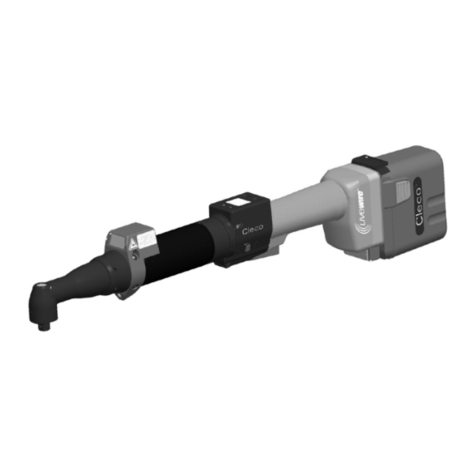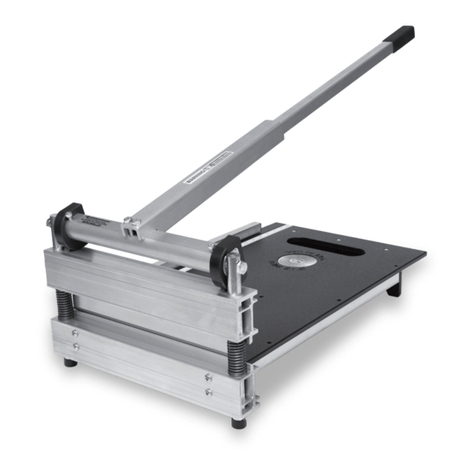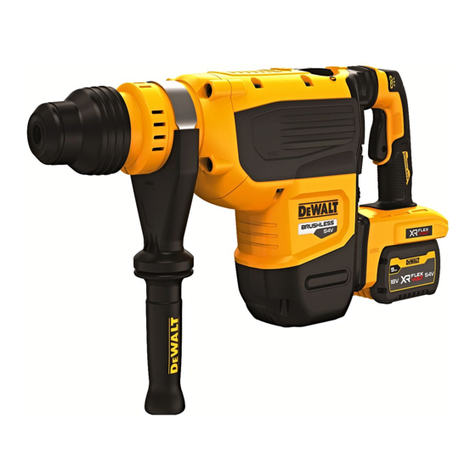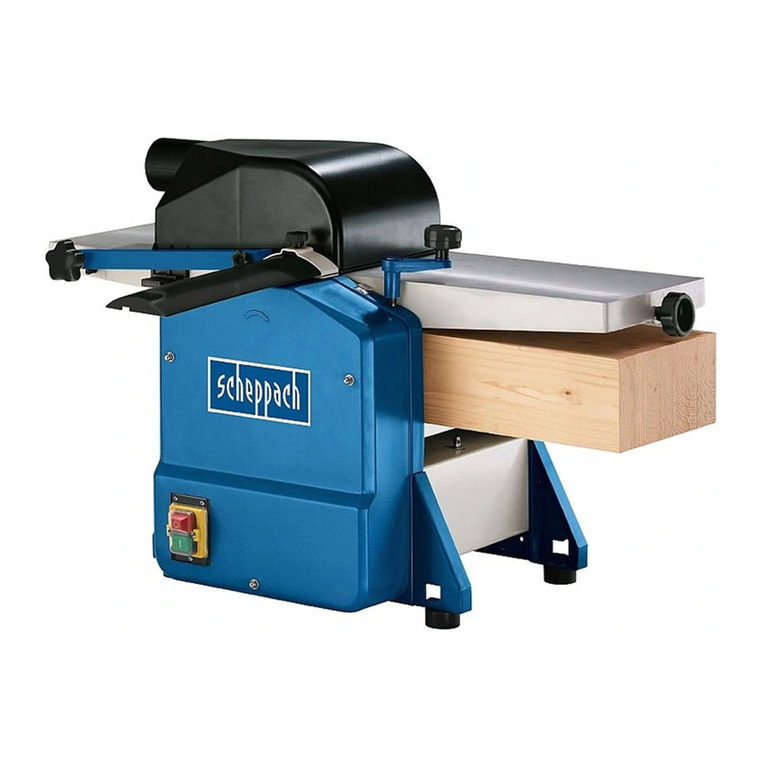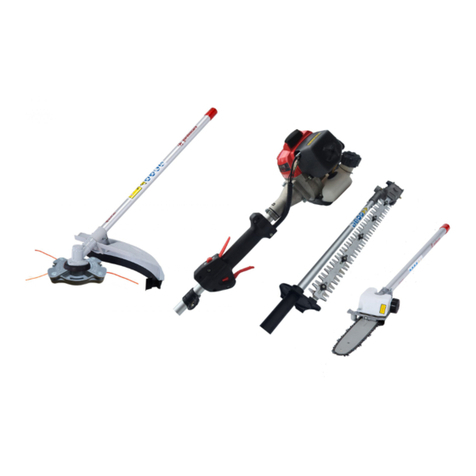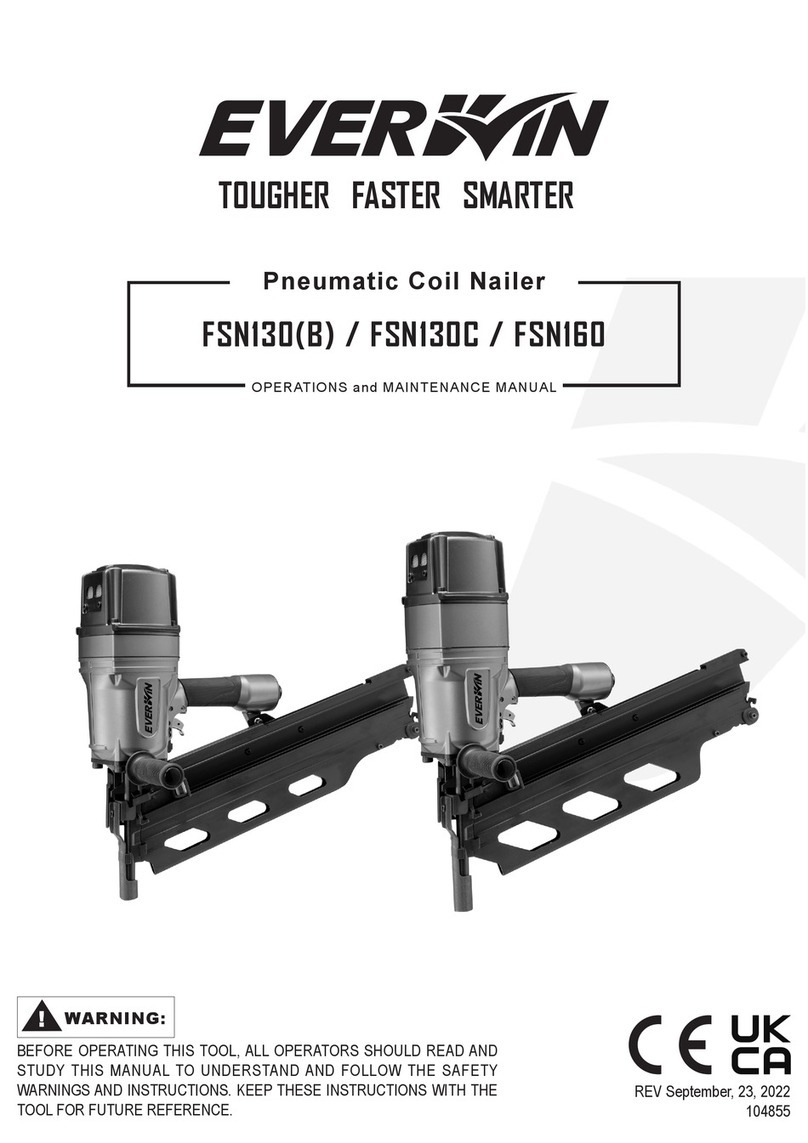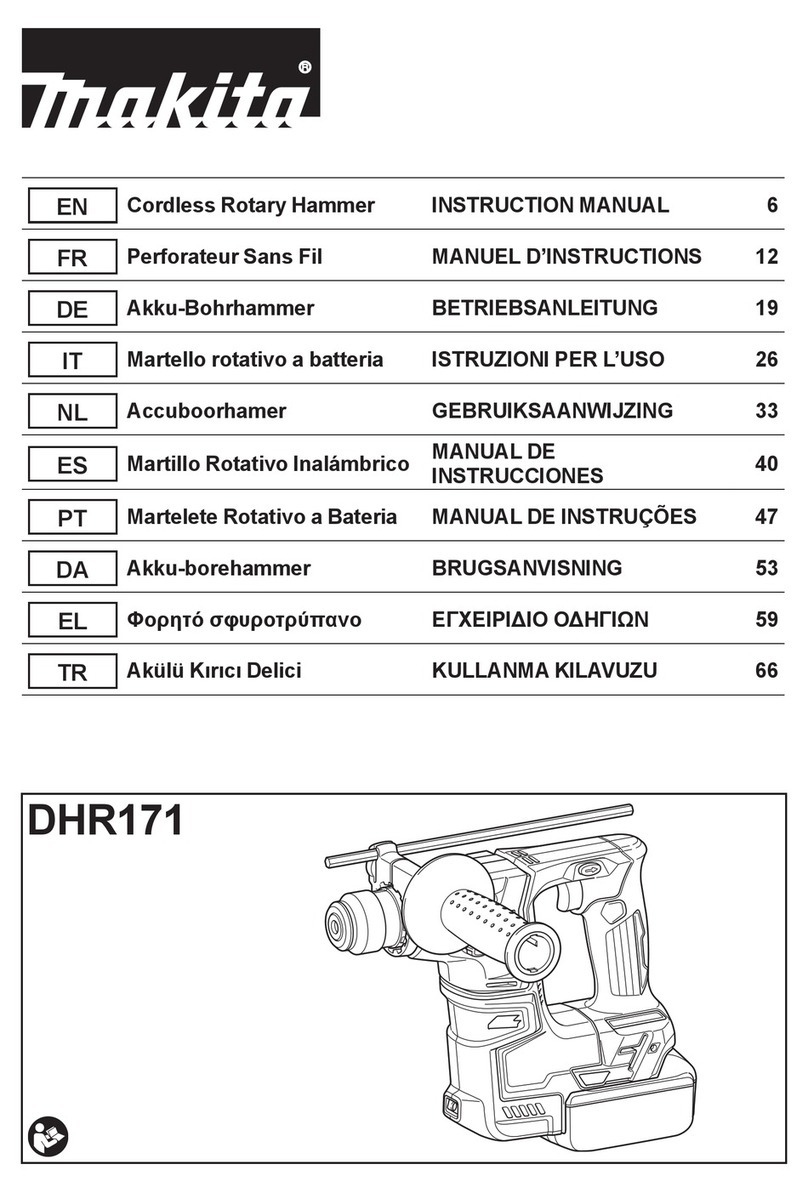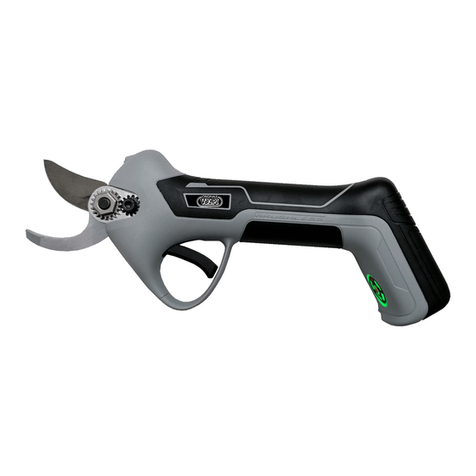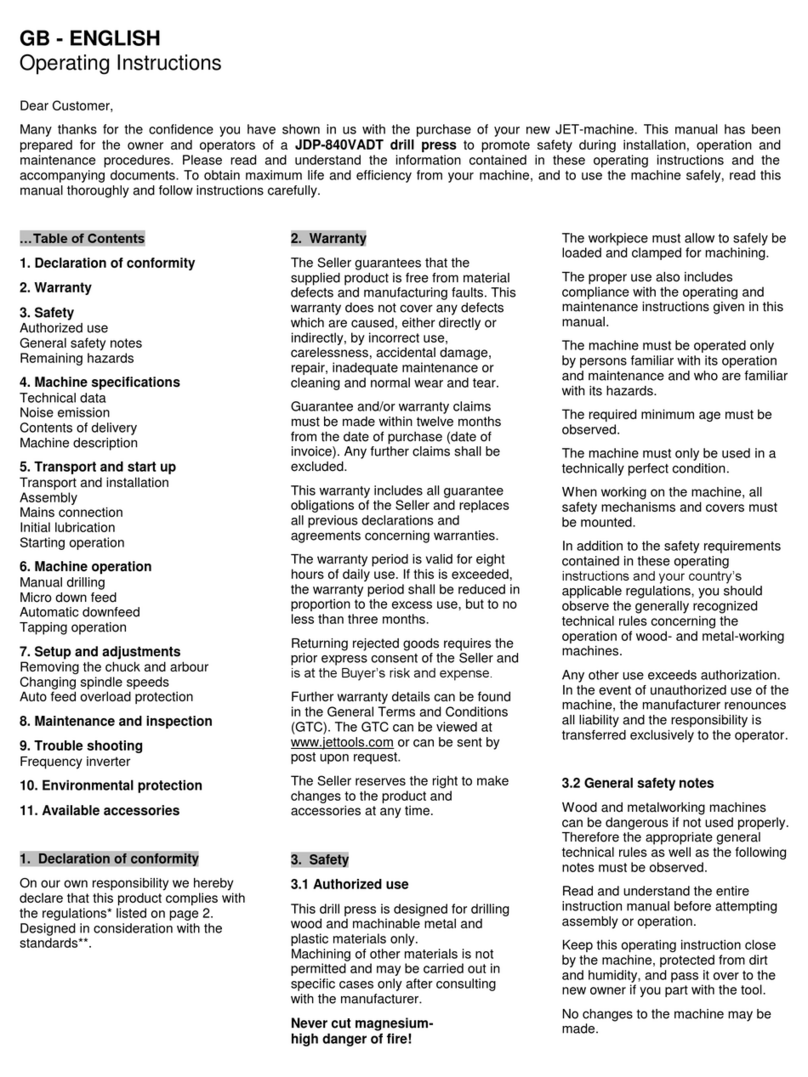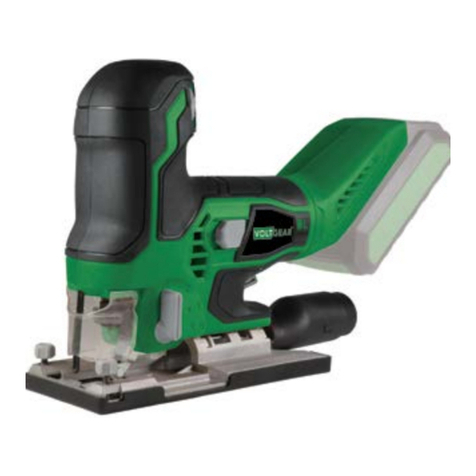Torin BIG RED JACKS TY30028 User manual

OWNER’S MANUAL
30 TON SHOP PRESS
Item: TY30028
Questions, problems, missing parts? Before returning to your retailer, call our customer service department at
1-888-44-TORIN (1-888-448-6746), 8 a.m.- 5 p.m., PST, Monday-Friday.
Read carefully and understand all ASSEMBLY AND OPERATION INSTRUCTIONS before operating. Failure
to follow the safety rules and other basic safety precautions may result in serious personal injury.
Version 07042017

2
IMPORTANT
OWNER / USER RESPONSIBILITY
INTENDED USE
TECHNICAL SPECIFICATIONS
Before You Begin Register This Product.
For future reference, record the model name, model number, date of manufacture and purchase date of this
product. You can nd this information on the product.
Model Name ________________________
Model Number ________________________
Date of Manufacture _______________________
Date of Purchase ________________________
Description
Item TY30028
Capacity 30 TON
Working Press (PSI) 100 - 175 PSI
Air Inlet Size (ZG) 1/4 inch
Work Range 2 ~ 44-1/2 inch
Stroke Length 5-7/8 inch
Inside Bed Dimensions L x W 21-5/8 x 6-1/4 inch
Dimensions L x W x H 34-13/16 x 27-1/2 x 72-7/16 inch
Foot Switch Included NO
Winch Included NO
DO NOT OPERATE OR REPAIR THIS PRODUCT WITHOUT READING THIS MANUAL.
Read and follow the safety instructions. Keep Instructions readily available for operators. Make certain all
operators are properly trained and understand how to safely and correctly operate the product. By proceeding
you agree that you fully understand and comprehend the full contents of this manual. Failure to operate this
product as intended may cause injury or death. The manufacturer is not responsible for any damages or injury
caused by improper use or neglect. Allow product operation only with all parts in place and operating safely.
Use only genuine replacement parts. Service and maintain the product only with authorized or approved
replacement parts; negligence will make the product unsafe for use and will void the warranty. Carefully
inspect the product on a regular basis and perform all maintenance as required. Store these instructions
in a protected dry location. Keep all decals on the product clean and visible. Do not modify and/or use for
any application other than that for which this product was designed. If you have any questions relative to a
particular application, DO NOT use the product until you have rst contacted the distributor or manufacturer to
determine if it can or should be performed on the product.
For technical questions please call 1-888-448-6746.
This equipment is designed for automotive, truck, implement, eet, and industrial repair shops where pressing,
bending, straightening and forming tasks are required. Typical applications include installation and removal of
alternator and power steering pump bearings, axle bearings, transmission bearings, seals, U-joints and many
other jobs.

3
GENERAL SAFETY RULES
GENERAL SAFETY RULES
IMPORTANT SAFETY CONSIDERATIONS
WARNING: Read and understand all instructions. Failure to follow all instructions listed below may result
in serious injury.
WARNING: The warnings, cautions, and instructions discussed in this instruction manual cannot
cover all possible conditions or situations that could occur. It must be understood by the operator
that common sense and caution are factors which cannot be built into this product, but must be supplied
by the operator.
CAUTION: Do not allow persons to operate or assemble this jack until they have read this manual and
have developed a thorough understanding of how the jack works.
SHOP PRESS USE AND CARE
INSPECTION
• Do not modify the Shop Press in any way. Unauthorized modication may impair the function and/or
safety and could affect the life of the equipment. There are specic applications for which the Shop Press
was designed.
• Always check of damaged or worn out parts before using the Shop Press. Broken parts will affect the
Shop Press operation. Replace or repair damaged or worn parts immediately.
• Store idle Shop Press. When jack is not in use, store it in a secure place out of the reach of children.
Inspect it for good working condition prior to storage and before re-use.
• Not for use by children or people with reduced mental capacity.
• Do not use under the inuence of drugs or alcohol.
• Ensure children and other bystanders are kept at a safe distance when using shop press.
• Inspect the shop press carefully before each use. Ensure the shop press is not damaged, excessively worn,
or missing parts.
• Do not use the shop press unless it is properly lubricated.
• Using a shop press that is not in good clean working condition or properly lubricated may cause serious
injury.
• Inspect the work area before each use. Make sure it is free and clear of any potential hazards.

4
SAFETY MARKINGS
WARNING!
1. Study, understand, and follow all instructions before operating the device.
2. Do not exceed rated capacity.
3. Prior to use, make sure the press is securely anchored.
4. The press shall be installed and operated in accordance with federal (OSHA), state, and local safety
standards.
5. Ensure the work area is clean and free of any hazards before operation.
6. Operators and observers shall wear eye protection that meets ANSI Z87.1 and OSHA standards.
7. Keep hands, arms, feet, and legs out of the work area. Accidental slippage can result in personal injury.
8. Use appropriate guarding to contain any pieces that may break or y apart when applying force.
9. Use only press accessories having a capacity rating equal to or greater than the capacity of the press.
10. Verify lift cables are slack before pressing on the bolster.
11. Avoid off-center loads.
12. No alterations shall be made to the product.
13. Do not use this press for any use other than the manufacturer specied usage.
14. Failure to heed and understand these instructions and markings may result in personal injury, property
damage, or both.
DO NOT OPERATE OR REPAIR THIS EQUIPMENT WITHOUR READING THIS MANUAL.
To maintain the Shop Press and user safety, the responsibility of the owner is to read and follow these
instructions. Inspect the service shop press for proper operation and function. Keep instructions readily
available for equipment operators. Make certain all equipment operators are properly trained; understand
how to safely and correctly operate the unit. Allow unit operation only with all parts in place and operating
properly. Use only genuine replacement parts. Service and maintain the unit only with authorized or approved
replacement parts negligence will make the shop press unsafe for use and void the warranty. Carefully inspect
the unit on a regular basis and perform all maintenance as required. Store these instructions in the handle of
your shop press. Keep all decals on the unit clean and visible.
Safety: always follow safety precautions when installing and operating this shop press. Keep all decals on
the unit clean and visible. Before proceeding that you fully understand and comprehend the full contents of
this manual. Failure to operate this equipment as directed may cause injury or death. The distributor is not
responsible for any damages or injury caused by improper use or neglect.

5
GENERAL SAFETY INSTRUCTIONS
PLEASE READ THESE INSTRUCTIONS CAREFULLY. NOTE THE SAFETY INSTRUCTIONS AND
WARNINGS. USE THE PRODUCT CORRECTLY AND WITH CARE FOR THE PURPOSE OF WHICH IT IS
INTENDED. FAILURE TO DO SO MAY CAUSE DAMAGE TO PROPERTY AND/OR SERIOUS PERSONAL
INJURY. PLEASE KEEP THIS INSTRUCTION MANUAL SAFE FOR FUTURE USE.
We’ve done all we can to assure this press offers the outmost in safety, but you have to do your part. No
amount of warning can take the place of your good judgment, so make sure it’s the rst thing you bring to any
job. Beyond that here are some obvious tips:
• Steel and other materials can shatter, so always use protective eyewear that complies with the appropriate
ANSI code.
• If you detect anything that may indicate imminent structural failure, stop using the press immediately and
inspect it thoroughly.
• Bolt the press to the oor if it is to be used on bulky or unstable items.
• Do not use press to compress springs or any other item that could disengage and cause a potential ying
hazard.
• Use this press for the purpose for which it is intended. Do not use it for any other purpose it is not designed
to perform.
• Keep children and unauthorized persons away from the work area.
• Contain loose tting clothing. Remove ties, watches, rings and other loose jewelry and contain long hair.
• Wear ANSI approved impact safety goggles, full-face impact safety shield and heavy-duty work gloves
when operating the press.
• Keep proper balance and footing, do not overreach and wear nonskid footwear.
• Only use this press on a surface that is stable, level, dry and not slippery, and capable of sustaining
the load. Keep the surface clean, tidy and free form unrelated materials and ensure that there is adequate
lighting.
• Inspect the press before each use. Do not use if bent, broke, cracked, leaking or otherwise damaged. Do
not use if any suspect parts are noted or if the shop press has been subjected to a shock load.
• Check to ensure that all applicable bolts and nuts are rmly tightened.
• Ensure that work piece is center-loaded and secure.
• Keep hands and feet away from bed area at all times.
• Do not use the shop press to compress spring or any other item that could disengage and cause a potential
hazard. Never stand directly in front of loaded press and never leave loaded press unattended.
• Do not operate the press when you are tired or under the inuence of alcohol, drugs or an intoxicating
medication.
• Do not allow untrained persons to operate the press.
• Do not make any modications to the press.
• Do not use brake uid or any other improper uid and avoid mixing different types of oil when adding
hydraulic oil. Only good quality hydraulic jack oil can be used.
• Do not expose the press to rain or any other kind of bad weather.
• If the press needs repairing and/or there are any parts that need to be replaced, have it repaired by
authorized technicians and only use the replacement parts supplied by the manufacturer.
WARNING! The warnings, cautions and instructions discussed in this manual cannot cover all conditions and
situations that may occur. It must be understood by the operator that common sense and caution are factors
which cannot be built into this product, but must be supplied by the operator.

6
ASSEMBLY
All numbers in parenthesis () refer to the index number from the parts breakdown
1. Attach the two base support sections (21) to
the frame (6) with bolt (24), washer (18), spring
washer (19) and nuts (20).
3. Attach the hydraulic air pump (28) to the frame
assembly (6) with spring washer (34) and bolt
(28). Ensure that the hydraulic air pump (40) is
securely installed.
Note: DO NOT drop hydraulic air pump during
installation. Pump could be damaged if dropped or
unsecured! Check that pump is secure before
releasing your hold of the hydraulic air pump.
2. Attach support rail #1 (22) and support rail #2 (25)
to base (21) and frame assembly (6) with bolt (24),
washer (18), spring washer (19) and nuts (20).
4. Locate the hydraulic hose connection (33) on
hose and power unit assembly (28). Install the
O-ring (9) into the groove of the hose connection
fitting (33). Then Connect the hydraulic hose
to (33), to the power unit assembly (28).Use a
wrench to securely tighten the hose tting on the
power unit assembly (28).
24
21 19
18
20
6
24
25
19
21
18
20
6
22
35 34
6
28
9
28
33

7
5. Install the pressure gauge (12) to the top of frame
(6), with M20 thin nut (10). Hand tighten the
pressure gauge (12) with M20 nut (10) and make
sure dial gauge is is facing proper direction up.
Tight gauge securely.
6. Locate the hydraulic hose T-fitting on the hose
assembly (33). Install the O-ring (9) into the
groove of the hose connection T-tting (33). Then
Connect the hydraulic hose to (33), to the gauge
(12). Securely tighten the hose T-tting( 33)on the
gauge(12) .
8. Locate the male hydraulic hose coupling (33)
and attach to the cylinder(2) Tighten with wrench
securely.
7. Insert the cylinder assembly (2) from the topside
of frame. Once the cylinder is inserted intothe
cylinder base (8) make sure that the roundlifting
ring is seated at on the cylinder base (8). Then
attach the round nut (R2) to the cylinderassembly.
Turn clockwise to screw the roundnut (R2) onto
threaded shaft on the ram. Tightenround nut (R2).
33 2
R2
2

8
11. Insert the handle (29) into handle sleeve of the
hydraulic pressure pump (28). Check for proper
pump action.
12. Verify that all bolts and screws have been
tightened.
13. The press is now ready for use.
10. Place the bolster plate (14) on lower bolster (15).
15
14
9. Raise the lower bolster (15) to the desired height
and insert the bed frame pins (17) into the holes
on the frames (6). Secure the pins (17) with spring
clips (16)
CAUTION: Press bed frame is heavy and could
cause a potential hazard. Raise press bed frame
with 2 or more people.
15
17
16
29
28

9
3. Firmly close the Release Valve by turning it
clockwise.
4. With the release valve closed, connect the air inlet
tting, to shop air supply.
A.Supply air to pump by pushing the air trigger valve
on the shop press hose connection. Allow the
pump to work for ten seconds.
B.After 10 seconds release the air trigger valve, so
air supply stops to pump.
C.Then pump the handle for ten pumps.
2. Connect the air inlet tting, to shop air supply.
A. Supply air to pump by pushing the air trigger
valve on the shop press hose connection. Allow
the pump to work for ten seconds.
B. After 10 seconds release the air trigger valve, so
air supply stops to pump.
C.Then pump the handle for ten pumps.
SYSTEM AIR PURGE PROCEDURE
IMPORTANT: BEFORE FIRST USE
All numbers in parenthesis () refer to the index number from the parts breakdown.
Perform the following Air Purge Procedure to remove any air that may have been introduced into the hydraulic
system as a result of product shipment and handing. This step is to be completed without and weight on the
jack.
1. Open the Release Valve by turning counter-
clockwise to release the pressure in the pump
and hose.
Air tting inlet Air tting inlet

10
5. Turn the Release Valve counterclockwise and
retract the piston rod.
6. Remove the oil plug to purge air.
7. Replace oil plug.
16

11
BEFORE USE
OPERATION
1. Before using this product, read the owner's manual completely and familiarize yourself thoroughly with the
product and the hazards associated with its improper use.
2. Perform the air purge procedure. (See previous instructions for system purge procedure.)
3. Inspect before each use. Do not use if bent, broken or cracked components are noted.
All numbers in parenthesis () refer to the index number from the parts breakdown.
1. Insert the bed frame pins (17) to desired height, then lower the lower bolster (15) on to pins. Ensure lower
bolster is fully rested on the bed frame pins.
2. Place bolster plates (14) on lower bolster (15).
15
14
15
17
16

12
3. Place work piece on the bed frame or pressing block, use every precaution necessary to ensure safety and
to prevent accidents. Position work piece in a manner which will not allow it to inadvertently fall from the
bed frame or pressing block.
4. Close the release valve by turning it clockwise until it is rmly closed.

13
6. When work is complete, turn off the air valve (or stop pumping handle), Slowly turn the release valve
counter-clockwise in small increments until ram is free from work piece.
7. Once ram has fully retracted, remove work piece from bed frame. Cautiously remove work piece frompress.
5. Connect the air inlet tting, to shop air supply. Pump air into the system until the ram nears the work piece.
Then release the trigger when pumping needs to stop. OR When an air source is unavailable, pump the
handle until the ram nears the work piece.
CAUTION: Before beginning applying full pressure to work piece, keep ram and work piece aligned to
ensure center-loading. Do not overload workpiece.
Air tting inlet

14
MAINTENANCE INSTRUCTIONS
If you use and maintain your equipment properly, it will give you many years of service. Follow the
maintenance instructions carefully to keep your equipment in good working condition. Never perform any
maintenance on the equipment while it is under a load.
Inspection
You should inspect the product for damage, wear, broken or missing parts (e.g.: pins) and that all components
function before each use. Follow lubrication and storage instructions for optimum product performance.
Binding
If the product binds while under a load, use equipment with equal or a larger load capacity to lower the load
safely to the ground. After un-binding; clean, lubricate and test that equipment is working properly. Rusty
components, dirt, or worn parts can be causes of binding. Clean and lubricate the equipment as indicated in
the lubrication section. Test the equipment by lifting without a load. If the binding continues contact Customer
Service.
Cleaning
If the moving parts of the equipment are obstructed, use cleaning solvent or another good degreaser to clean
the equipment. Remove any existing rust with a penetrating lubricant.
Lubrication
This equipment will not operate safely without proper lubrication. Using the equipment without proper
lubrication will result in poor performance and damage to the equipment. Some parts in this equipment are not
self-lubricating inspect the equipment before use and lubricate when necessary. After cleaning, lubricate the
equipment using a high grade light penetrating oil or lubricating spray.
• Use a good lubricant on all moving parts.
• For light duty applications, use lubrication once a month.
• For heavy and constant use, lubrication is recommended every week.
• NEVER USE SANDPAPER OR ABRASIVE MATERIAL ON THESE SURFACES!
Rust Prevention:
Check rams and pump plungers on the power unit assemblies daily for any signs of rust or corrosion.
Without a load on the equipment extended hydraulic rams to check if signs of rust are visible; clean as
needed.
Grease Fittings
Some models contain grease ttings that will regularly need to be greased and lubricated.
How the Ram Operates
With release valve closed, an upward stroke of the jack handle draws oil from the reservoir tank into the
plunger cavity. Hydraulic pressure holds the valve closed, which keeps the oil in the plunger cavity. A
downward stroke of the jack handle releases oil into the cylinder, which forces the ram out. This extends the
ram. When the ram reaches maximum extension, oil is bypassed back into the reservoir to prevent an over
extended ram stroke and possible damage to the ram. Opening the release valve allows oil to ow back into
reservoir. This releases hydraulic pressure on the ram, which results in lowering the ram.
Storing the Ram
1. Fully Retract Ram after use.
2. Place the handle in the upright position.
3. Store in a dry location, recommended indoors.
Note: If the press is stored outdoors, be sure to lubricate all parts before and after use to ensure the press
stays in good working condition.

15
TO ADD JACK OIL:
The hydraulic cylinder assembly contains hydraulic uid that must be kept at approximately 80% full at all
times for proper operation. To check the level and to ll remove oil ller plug.
1. Fully retract the hydraulic ram.
2. Remove the oil plug.
3. Fill the oil case until oil level is just beneath the
lower rim of the oil ll hole.
KEEP DIRT AND OTHER MATERIAL CLEARWHEN
POURING.
4. Replace oil plug.
5. Perform the Air Purge Procedure.
TO REPLACE JACK OIL
1. Fully retract the hydraulic ram and remove pump
from hose and frame.
2. Position the pump in the vertical position on a at
level surface.
3. Open release valve by turning handle counter-
clockwise (4 full turns).
63

16
4. Remove the oil plug.
6. Fill the oil case until oil level is just beneath the
lower rim of the oil ll hole.
KEEP DIRT AND OTHER MATERIAL CLEAR
WHEN POURING.
7. Replace oil plug.
8. Perform the Air Purge Procedure.
• DO NOT USE MOTOR OIL IN THE JACK.
• ONLY USE ANTI-FOAMING JACK OIL.
• ALWAYS USE A GOOD GRADE HYDRAULIC
JACK OIL.
• DO NOT USE HYDRAULIC BRAKE FLUID,
ALCOHOL, GLYCERINE, DETERGENT, MOTOR
OIL OR DIRTY OIL.
• USE OF A NON-RECOMMENDED FLUID CAN
CAUSE DAMAGE TO A JACK.
• AVOID MIXING DIFFERENT TYPES OF FLUID
AND NEVER USE BRAKE FLUID, TURBINE
OIL, TRANSMISSION FLUID, MOTOR OIL OR
GLYCERIN. IMPROPER FLUID CAN CAUSE
PREMATURE FAILURE OF THE JACK AND THE
POTENTIAL FOR SUDDEN AND IMMEDIATE
LOSS OF LOAD.
• DISPOSE OF HYDRAULIC FLUID IN
ACCORDANCE WITH LOCAL REGULATIONS.
5. Turn the jack on its side so that old oil will drain
from the oil ll hole.
Note: Dispose of hydraulic uid in accordance
with local regulations.
ADDITIONAL WARNINGS:
63

17
LUBRICATION
A periodic coating of light lubricating oil to pivot points will help to ensure that pump pistons move freely.
Note: Never apply oil to the saddle. If saddle extension threads require lubrication; clean thread surfaces with
a clean, dry cloth, then apply a drop of bearing grease to the threads. Distribute as evenly as possible along
the threaded post.
1. Clean the outside of the press with a dry, clean, and soft cloth. Periodically lubricate all joints and moving
parts with a long lasting lubrication oil. Apply as needed.
2. When not in use, store the press in a dry location with ram and pump piston fully retracted. Periodically
check the rams for signs of rust or corrosion. Clean as needed and wipe with a soft non-abrasive clean
cloth.
Clean
Fully
Retracted
Fully
Retracted
Clean

18
TROUBLESHOOTING
RAM
WILL NOT
PRESS
LOAD
RAM BLEEDS
OFF AFTER
PRESS
OPERATION
RAM WILL NOT
RETRACT
AFTER
UNLOADING
POOR LIFT
PERFORMANCE
RAM WILL
NOT EXTEND
TO FULL
EXTENSION CAUSES AND SOLUTIONS
Release valve not tightly closed.
Ensure release valve tightly closed.
Overload condition.
Remedy overload condition.
Power unit malfunctioning.
Replace the power unit.
Reservoir overlled.
Remove pump, then drain uid to
proper level.
Linkage binding.
Clean and lubricate moving parts.
Fluid level low.
Ensure proper uid level.
Air trapped in system.
Purge air from system.
X XX
X
X XX
X X
X X
X XX
X
Safe Operating Temperature is between 40°F – 105°F (4°C - 41°C)

19
ASSEMBLY DIAGRAM
Optional
Optional

20
No. Part Description Qty
1 QF4.6(ASM) Female couping valve 1
2 TY30028.1 Cylinder assembly 1
3 Hex head bolt M8x110mm 4
4 Spring 4
5 Roller shaft 2
6Frame assembly 1
7 Cup point set screw M5x8mm 4
8 Cylinder base 1
9 TY20021-12 O-ring D5x1.8g 5
10 Nut M20-2 1
11 TY12001.1-15 Rectangular seal 1
12 TY30021-01 Gauge (0-45 Ton) 1
13 TY30021-08 Gauge connector 1
14 TY20021b.3 Bolster plate 2
15 Lower bolster 1
16 TY20021-14 Round wire snap ring 8
17 TY30021-06 Bed frame pins 4
18 Nut M12 14
19 Spring washer M12 14
20 Washer M12 14
21 Base 2
22 Support bar #1 1
23 Hex head bolt M12x25mm 4
24 Hex head bolt M12x30mm 10
25 Support bar #2 3
26 TY20002.1.1a Pneumatic trigger assembly 1
27 TY20002.1.2 Air pump 1
28 TY30021.5a Power unit assembly 1
29 TY20028.2(ASM) Handle 1
30 TY20001.4.2(ASM) Release valve assembly 1
31 GB308-6 Steel ball bearing Ø6mm 1
32 T815005L.3-24(ASM) Bleed screw 1
33 TY30021-04(ASM) Hydraulic hose assembly 1
34 GB93-10 Spring washer M10 4
35 GB5783-M10x25 Hex head bolt M10x25mm 4
36 QF4.4 Male couping valve 1
37 Roller bearing 6201-2Z 4
38 Side-mount external retaining ring Ø9mm 4
39 TY20021F.11(ASM) Safety guard 1
40 TY20021.6(ASM) Punch adapter kit 1
41 TY30028.MF Seal kit 1
Table of contents
Languages:
